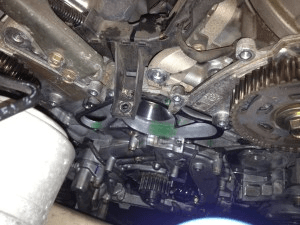CAR OVERHEATING? THERE’S A REASON FOR THAT.
American Pride Automotive • January 31, 2012

The water pump is one place coolant can leak, be sure to have the timing belt and water pump changed on time.
Although a great car may be aesthetically pleasing on the outside and have tons of high-tech features on the inside, it means nothing if the car is plagued with mechanical issues. While overheating may seem like a simple issue, it really isn’t, and pinpointing the exact reason for overheating can be quite difficult, especially if you aren’t a car expert. Even though the causes for car overheating are numerous, there are about three that stand out as the most frequently occurring
Radiator Fan Malfunction
Most cars have electric cooling fan motors in place behind the radiator to assist with temperature regulation. If your car doesn’t have electric cooling fans, it’ll definitely have a belt-driven fan. If either of the fans aren’t working as intended, you’ll experience some overheating. A good way to determine if fan malfunction is the cause of your overheating is observing when the overheating takes place. If your car starts to heat up while at rest, it’s most likely a fan-related issue. Try checking the airflow of your fans, or take your car to a repair specialist if you’re not comfortable with doing that.
Coolant Problems
Apart from the airflow, coolant is the main way a car stays cool. Without proper antifreeze circulation, your car will overheat rather easily. Again, pay attention to when your car overheats; if it overheats during 30-60mph drives, then it’s most likely a coolant issue. Unfortunately, the coolant circulation system in most cars is complex, which means there’s a number of things that could go wrong. Generally, you’ll want to check if your thermostat is fully functional, but it’s usually better to take it to a repair shop and have an expert look at it.
Leaks
If your coolant level is low, then there’s a high chance that you have a leak somewhere in your car. Since most cars have closed cooling systems, your coolant levels should never really go down. Determining whether you have a leak in your system is rather easily. First, make sure your radiator is filled with the right amount of coolant. Then, while your engine is running, observe your car; if you see any obvious leaks, then it’s time to head to the shop. There are some less obvious signs of leaks to watch out far as well, such as bubbles in your expansion tank. Coolant leaks can lead to damage, so it’s best to get it fixed as soon as possible.

You’re driving home at night and it is raining cats and dogs. You can’t see but 20 feet in front of your car, but you’ve slowed down and are being extra cautious, so what could go wrong? Then you feel it. A sinking Cl-clunk. Maybe that “puddle” you saw ahead of you was deeper than just a puddle. Before you know it, your car is stalling in the high water in the middle of the road. Now what? First off, don’t panic. Turn on your hazards and crank the ignition once. If the car starts, make it dry land and pull over to assess the damage. If it does not start the first time, do not try to start it again. Doing so can result in a hydro locked engine and will likely necessitate the rebuilding or replacement of the engine. Unfortunately, if you find yourself stalling in water at all, your vehicle will probably need costly repairs. The best way to avoid water damage is to practice safe and smart driving in wet weather, which brings us to Part 2 of the Everything Auto “Blame it on the Rain” series (Find Part 1 here). Take heed of these severe weather driving tips: 1. TAKE NO CHANCES ON PUDDLES Even if the standing water ahead of you looks shallow enough to drive through, think twice. If the water is “rushing” or if other drivers are making a point to avoid it, don’t assume that your vehicle is the exception. Additionally, you never know the hazards that lay at the bottom of a puddle. Hidden potholes or debris can pierce your tires and jostle your alignment and suspension system. 2. IF YOU MUST TAKE A CHANCE, TAKE IT SLOW AND STEADY When you deem it necessary and safe to drive through water of questionable depth, go slowly. Speeding through a puddle, even a shallow one, can splash water into your vehicle’s intake and critically harm the engine. Like we mentioned last week, after driving through standing water, lightly tap your brakes to make sure they aren’t saturated and to dry them off. 3. KEEP A ROADSIDE EMERGENCY KIT HANDY Sometimes, no matter how careful you are on the road, accidents and vehicle malfunctions happen, especially in wet severe weather. That’s why it is extremely important to keep emergency supplies ready in the trunk for the worst case scenario. You can buy a preassembled one, but it is cheaper (and more rewarding) to assemble your own. What should you include? Edmunds.com provides an excellent comprehensive list of items, a few of which include: 12-foot jumper cables Four 15 minute road flares Two quarts of oil A gallon of antifreeze A first-aid kit. Find the rest of the list here We hope that this series has given you helpful safety insights and tips for driving in the rain! Remember that American Pride Automotive is always here to help and ready to answer any and all of your auto repair and maintenance questions! Call or contact us today.
